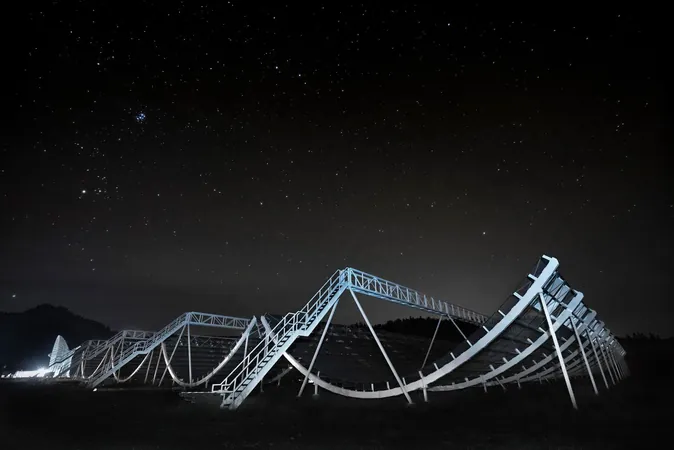
Shocking Discovery: An Ancient Galaxy is Home to a Newly Found Fast Radio Burst!
2025-01-23
Author: John Tan
Introduction
Fast radio bursts (FRBs) are enigmatic flashes of radio light that blaze for mere milliseconds, captivating astronomers and astrophysicists alike. Most of these mysterious cosmic signals originate from beyond our Milky Way, although a few have been traced to sources within our galaxy. What's particularly intriguing is that while some FRBs repeat, indicating they're not caused by singular cataclysmic events like supernovae, their actual origins remain shrouded in mystery. A recent breakthrough has unveiled exciting new details about these bursts.
The Discovery of FRB 20240209A
A study featured in The Astrophysical Journal Letters focuses on FRB 20240209A, a repeating burst first detected by the CHIME radio telescope in February 2024. Over a span of four months, astronomers recorded this particular FRB a staggering 21 times. These repeat occurrences allowed scientists to observe six events from a separate observatory located just 60 kilometers away. Remarkably, they traced the origin of this FRB to a galaxy that lies an astonishing two billion light-years from Earth.
Unusual Location of the FRB
What sets this discovery apart is the unusual location of the FRB within its galaxy. Unlike typical FRBs that originate from the central star-forming regions of galaxies, this one emerged from the outskirts of an ancient galaxy over 11 billion years old—well beyond its prime star-forming phase. This raises profound questions since neutron stars, which generate FRBs, are formed from the remnants of massive stars that go supernova. Such colossal stars have relatively brief lifespans, so the existence of an FRB in such an old galaxy suggests that the neutron star responsible must also harbor a lengthy history.
Challenging Conventional Ideas
Traditionally, the scientific consensus was that FRBs originate from young magnetars, powered by energetic magnetic flares akin to solar flares from our Sun. However, neutron stars cool and eventually become dormant over time, prompting skepticism about old stars producing FRBs. This groundbreaking study indicates that older neutron stars might still be active and capable of generating these dramatic radio bursts, challenging conventional ideas about their lifecycle.
Possible Theories
One possible theory posits that the FRB may have emitted not from the galactic edge but rather from a dense globular cluster orbiting the galaxy, where various stellar mergers take place. Although the vast distance to this galaxy prevents definitive conclusions, it raises compelling prospects about the dynamics within these clusters. Some experts speculate that the FRB could stem from merging magnetars, wherein their magnetic fields interact and realign explosively, resulting in bursts of radio energy.
Conclusion
As scientists pursue further observations, it's becoming increasingly clear that the astrophysical processes responsible for FRBs are far more varied and complex than previously understood. Could this change our perception of neutron star evolution? Will future discoveries revolutionize our knowledge of the universe? Keep an eye on the cosmos, as the secrets of fast radio bursts and their origins continue to unfold!




 Brasil (PT)
Brasil (PT)
 Canada (EN)
Canada (EN)
 Chile (ES)
Chile (ES)
 Česko (CS)
Česko (CS)
 대한민국 (KO)
대한민국 (KO)
 España (ES)
España (ES)
 France (FR)
France (FR)
 Hong Kong (EN)
Hong Kong (EN)
 Italia (IT)
Italia (IT)
 日本 (JA)
日本 (JA)
 Magyarország (HU)
Magyarország (HU)
 Norge (NO)
Norge (NO)
 Polska (PL)
Polska (PL)
 Schweiz (DE)
Schweiz (DE)
 Singapore (EN)
Singapore (EN)
 Sverige (SV)
Sverige (SV)
 Suomi (FI)
Suomi (FI)
 Türkiye (TR)
Türkiye (TR)
 الإمارات العربية المتحدة (AR)
الإمارات العربية المتحدة (AR)